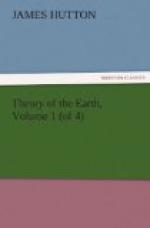[Note 24: Voyez le Memoire, imprime dans le XVII. volume des nouveaux Commentaires de l’Academie Imperiale de Petersbourgh.]
The question here turns upon this, Are the sea shells and glossopetrae, which are thus found deposited along with those skeletons, in their natural state, or are they petrified and mineralised. If the productions of the sea shall here be found collected along with bodies belonging to the surface of the earth, and which had never been within the limits of the sea, this would surely announce to us some strange catastrophe, of which it would be difficult, perhaps, to form a notion; if, on the contrary, those marine productions belong to the solid strata of the earth, in the resolution or decay of which they had been set at liberty, and were transported in the floods, our author would have no reason from those appearances to conclude, there had existed any other deluge than those produced by the waters of the land[25].
[Note 25: Since writing this, I find my doubts in a great measure resolved, in reading M. Pallas’s Journal, translated from the German by M. Gauthier de la Peyronie. What I had suspected is, I think, confirmed in the distinct account which M. Pallas has given of those occasions in which the bones of land animals and marine objects are found buried together. The marine objects are mineralised; consequently, they have proceeded from the decomposition of the solid strata; and, having been travelled in the running water of the surface of the earth, they must have been deposited in those beds of rivers, which now are dry, alongst with the bones, or the entire bodies of terrestrial animals, the remains of which are now found there. This argument, from the state of those marine bodies will not be allowed, perhaps by the generality of mineralists, who attribute to the operations of water every species of petrifaction or mineralisation; but, until some species of proof be given with regard to the truth of that theory, which vulgar error first suggested, I must reason from a theory, in proof of which I have given clear examples, and, I think, irrefragable arguments, which shall be more and more illustrated. Thus may be removed the necessity of a general deluge, or any great catastrophe, in order to bring together things so foreign to each other; but at the same time we would ascertain this fact, That formerly the Elephant and Rhinoceros had lived in Siberia. (See Voyage de Pallas, Tom. II. p. 377 and 403.)]




